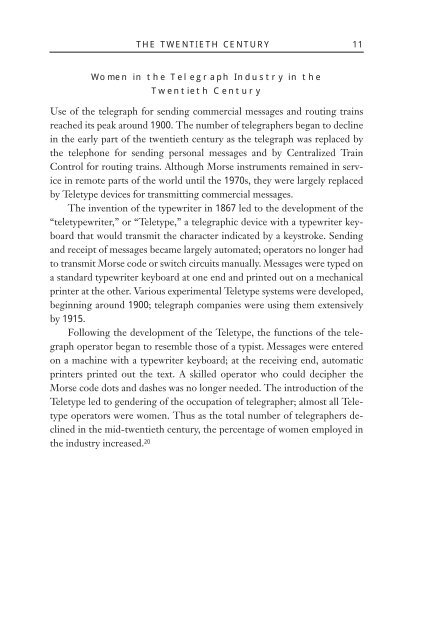My Sisters Telegraphic: Women in the Telegraph Office ... - Monoskop
My Sisters Telegraphic: Women in the Telegraph Office ... - Monoskop
My Sisters Telegraphic: Women in the Telegraph Office ... - Monoskop
You also want an ePaper? Increase the reach of your titles
YUMPU automatically turns print PDFs into web optimized ePapers that Google loves.
THE TWENTIETH CENTURY 11<br />
<strong>Women</strong> <strong>in</strong> <strong>the</strong> <strong>Telegraph</strong> Industry <strong>in</strong> <strong>the</strong><br />
Twentieth Century<br />
Use of <strong>the</strong> telegraph for send<strong>in</strong>g commercial messages and rout<strong>in</strong>g tra<strong>in</strong>s<br />
reached its peak around 1900. The number of telegraphers began to decl<strong>in</strong>e<br />
<strong>in</strong> <strong>the</strong> early part of <strong>the</strong> twentieth century as <strong>the</strong> telegraph was replaced by<br />
<strong>the</strong> telephone for send<strong>in</strong>g personal messages and by Centralized Tra<strong>in</strong><br />
Control for rout<strong>in</strong>g tra<strong>in</strong>s. Although Morse <strong>in</strong>struments rema<strong>in</strong>ed <strong>in</strong> service<br />
<strong>in</strong> remote parts of <strong>the</strong> world until <strong>the</strong> 1970s, <strong>the</strong>y were largely replaced<br />
by Teletype devices for transmitt<strong>in</strong>g commercial messages.<br />
The <strong>in</strong>vention of <strong>the</strong> typewriter <strong>in</strong> 1867 led to <strong>the</strong> development of <strong>the</strong><br />
“teletypewriter,” or “Teletype,” a telegraphic device with a typewriter keyboard<br />
that would transmit <strong>the</strong> character <strong>in</strong>dicated by a keystroke. Send<strong>in</strong>g<br />
and receipt of messages became largely automated; operators no longer had<br />
to transmit Morse code or switch circuits manually. Messages were typed on<br />
a standard typewriter keyboard at one end and pr<strong>in</strong>ted out on a mechanical<br />
pr<strong>in</strong>ter at <strong>the</strong> o<strong>the</strong>r. Various experimental Teletype systems were developed,<br />
beg<strong>in</strong>n<strong>in</strong>g around 1900; telegraph companies were us<strong>in</strong>g <strong>the</strong>m extensively<br />
by 1915.<br />
Follow<strong>in</strong>g <strong>the</strong> development of <strong>the</strong> Teletype, <strong>the</strong> functions of <strong>the</strong> telegraph<br />
operator began to resemble those of a typist. Messages were entered<br />
on a mach<strong>in</strong>e with a typewriter keyboard; at <strong>the</strong> receiv<strong>in</strong>g end, automatic<br />
pr<strong>in</strong>ters pr<strong>in</strong>ted out <strong>the</strong> text. A skilled operator who could decipher <strong>the</strong><br />
Morse code dots and dashes was no longer needed. The <strong>in</strong>troduction of <strong>the</strong><br />
Teletype led to gender<strong>in</strong>g of <strong>the</strong> occupation of telegrapher; almost all Teletype<br />
operators were women. Thus as <strong>the</strong> total number of telegraphers decl<strong>in</strong>ed<br />
<strong>in</strong> <strong>the</strong> mid-twentieth century, <strong>the</strong> percentage of women employed <strong>in</strong><br />
<strong>the</strong> <strong>in</strong>dustry <strong>in</strong>creased. 20

















